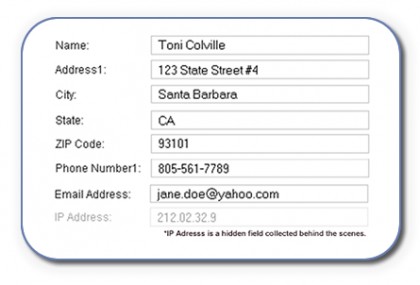I have been working with web services for over 6 years now and have helped many companies both big and small to resolve their frustration with the online world of bogus lead chaos and bad affiliate programs.
With all of the information and services available to help validate your inbound leads you need to make sure that it is doing more than just a simple check for validity. There are a lot of Lead Validation services out there claiming that they are the best, but let’s really ask ourselves, what are they doing that is so unique? How will they really be able to assure you that they are catching your bad leads?
Good Question.
Let’s take the following lead for example:

This lead looks pretty legitimate at first glance. Each piece of information entered on its own would definitely pass any simple web service validation check. The first and last name is valid, the address is valid, and the phone number is in the National Phone Database (NPA-NXX Phone Exchange Data), and the IP is a valid IP Address.
By just entering this lead into a simple contact validation service that does not cross validate the lead data then we are missing a crucial piece of the validation process. If you look further you’ll find that this lead is a seriously bad lead.
Here’s why:
1. I used my grandmother’s name
2. I used an address to a nearby business
3. I used a fake phone number that includes the local area code
4. I used an email address that looks valid
5. The IP address is located in Denmark
Toni Colville does not reside at 123 State Street #4 which happens to be a business address, the phone number has no contact information and is actually a disconnected number, and the national registry plots it in San Luis Obispo, a town 2 hours away from Santa Barbara, CA.
Here’s what information you should get back from this lead:
Warning: Phone number is disconnected.
Warning: IP Address is not in North America.
Warning: Location of IP address is greater than 400 miles from the address.
And if the phone number was made up, but is still a valid number, you should get a warning like this:
Warning: Phone number contact does not appear to match name or address.
And here are some other examples of warnings that would be nice to know depending on what was input:
Warning: No phone number was given.
Warning: Phone number is not valid.
Warning: Phone number is reserved.
Warning: Phone number contact does not appear to match name or address.
Warning: Phone number contact does not appear to match name, possible roommate or friend.
Warning: Phone exchange is greater than 150 miles from the address.
This kind of feedback will make a world of difference with your inbound automated lead qualification. Don’t waste your time and money calling an unknown number wondering if Toni Colville will really answer the other end of the line!
Here are some other crucial data elements to look for in a strong Lead Validation Web Service:
• Real-time Directory Assistance Data
• Billing Database
• Wireless Contact Database
• Firmographic Database
• USPS Address CASS & DPV Data
• NPA-NXX Phone Exchange Data
• US Census & TIGER/Line Data
• First & Last Name Databases
• Bogus String & Pattern Databases
• Valid/Invalid/Catch-all Email Server Data
• IP Provider & Fraudulent IP Data
So, don’t be fooled by fraudsters and data forgers; make sure your service cross validates all elements of the contact’s data; otherwise bypassing your online registration form will be entirely too easy.
Have more questions? We have answers. We are always happy to help.
Posted by: Ericka J.












